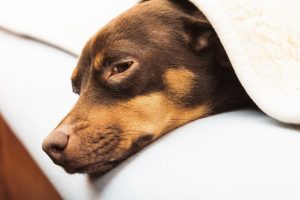Tummy in Knots? Recognizing and Preventing Bloat in Dogs
 Few conditions can kill a dog as quickly as bloat. Although many pet owners are unaware of it, bloat in dogs is one of the most serious, and potentially deadly, pet emergencies. Understanding the signs of bloat, as well as your emergency options, are crucial in protecting your dog from this dangerous affliction.
Few conditions can kill a dog as quickly as bloat. Although many pet owners are unaware of it, bloat in dogs is one of the most serious, and potentially deadly, pet emergencies. Understanding the signs of bloat, as well as your emergency options, are crucial in protecting your dog from this dangerous affliction.
Understanding Bloat in Dogs
Bloat, also known as gastric dilation volvulus (GDV), occurs when gas and fluid cause the stomach to distend. In some dogs, this distention can cause the stomach to twist along its axis (also called torsion), cutting itself off from the esophagus and duodenum.
Because of this torsion, gas builds up and the stomach distends further, cutting off the blood supply and causing cell death. Without treatment, a dog with bloat may die within a few hours.
If your dog is experiencing bloat, you may witness the following symptoms:
- Distended abdominal area
- Attempts to vomit or belch unsuccessfully
- Restlessness/acting uncomfortable
- Pacing
- Drooling
- Looking at stomach
- Reacting with pain when stomach is touched
- Collapse
Bloat in dogs is an extremely dangerous condition and should be considered a medical emergency. Most dogs with bloat will require surgery to remove any dead tissue and to repair the stomach and prevent the bloat from recurring.
Preventing GDV
All dogs are susceptible to bloat, but large, deep-chested breeds, such as the Great Dane, St. Bernard, and Weimaraner, are at increased risk. While the exact cause of bloat in dogs is unclear, there are certain steps dog owners can take to lower their pet’s risk:
- Feed your dog two smaller meals per day, rather than one large meal.
- Don’t feed your dog immediately before or after vigorous activity.
- Prevent your dog from eating too much, or too quickly.
- Prevent your dog from drinking large amounts of water in one sitting.
- Don’t feed your dog from a raised feeding bowl, keep it on the floor.
The Benefits of Preventive Gastropexy
If you are the owner of a breed that is prone to GDV, your veterinarian will make a point of discussing the benefits and risks of preventive gastropexy surgery for your dog.
During a gastropexy, the stomach is tacked to the abdominal wall, thus, preventing it from twisting due to distention. The stomach can still fill with air, but the risk of torsion is virtually eliminated.
Because we perform laparoscopic gastropexy at Lone Tree Veterinary Medical Center, we encourage our clients to have the procedure done in conjunction with a laparoscopic spay or neuter. However, elective gastropexy surgery may be performed at any time.
When in Doubt, Call Us
It can’t be stated enough that time is of the essence when it comes to the successful treatment of bloat in dogs. If you suspect your dog is suffering from bloat, contact us or bring your dog in immediately.
The knowledgeable and experienced staff at Lone Tree Veterinary Medical Center is available to answer your call at any time during the day while we are open, and will refer you to a reputable pet emergency facility if your pet needs assistance outside of our regular business hours.



